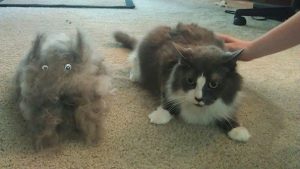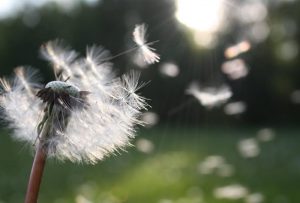Alas! spring is here (or it should be here by now…?)
What do we humans have in common with our furry little cuddly adorable feline friends at this time of year?: SHEDDING!!
All animals are affected by seasonal changes. Fall and Spring seem to be the two seasons where we, like cats and dogs, lose our “hair”. Cats shed their ‘summer coat’ in fall time to make room for their heavier winter coat and lose their heavy coat in the spring. This all has to do with the amount of sunlight during the day, not with the increase in temperature as we might think. If you continue reading, it’s a little different in human shedding, however…
It’s normal for us to lose 50~100 hairs a day. Hairs don’t grow at a constant rate. They go through a cycle that is broken down into 3 stages: Anagen (growth phase), Catagen (transition phase) and Telogen (resting phase). 85% of your scalp hairs are always (or should be) in the growing phase which lasts between 2~7 years. However, around 14% of your hairs would be in the resting phase when the hair bulb is completely keratinized and is pushed up towards the surface, ready to be shed. This phase lasts for about 3 months. Research suggests that hairs tend to go into telogen phase more so around end of July, making the shedding visible after 3 months in the fall time around October. The reason why this happens remains unclear. Some Swedish scientists have explained this phenomenon based on how we grow more hair during the summer months to protect our scalp from the stronger sun and UV rays. Come fall, and this extra growth of hair is no longer required, so they shed. Other research suggests that all the sun/heat damages, excess sebum from sweat clogging our follicles and dehydration of our scalp due to increased exposure to the AC during the hot summer months all cause hair loss by the fall.
Women may also experience slightly higher levels of hair loss during spring time, although it may be less obvious than that in the fall. This may be due to the crazy weather changes that usual take place during this time of year, increase in pollen, allergies and changes in diet. The lack of micro-circulation in the scalp and overall physical activity during the cold winter months have possibly clogged the pores and may be causing more hair loss.
Regardless, seasonal hair loss is normal. However, now that you’re more aware of how seasonal changes affect your scalp and hair growth, you may like to get into the habit of focusing on regular scalp care by making our Head Spa part of your beauty regime. This will ensure you maintain your scalp in optimal condition throughout the year. Making Head Spa part of your regular beauty regime will also prevent you from future serious cases of Alopecia.
Please stay tuned for my next blog on Progressive Hair Loss and how to treat it.
Thank you for reading! 🙂
#yokoshautecoiffure #headspa #hairspa #headmassage #seasonalhairloss




